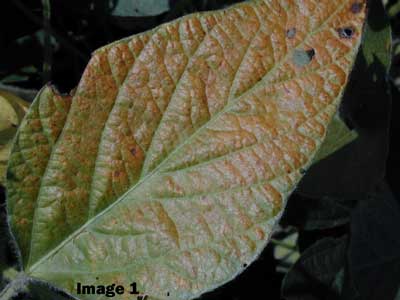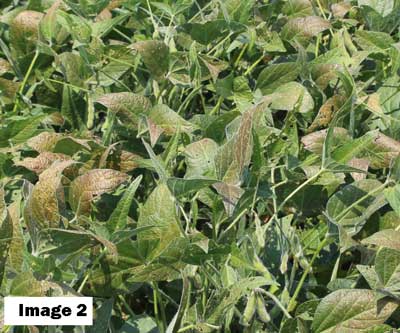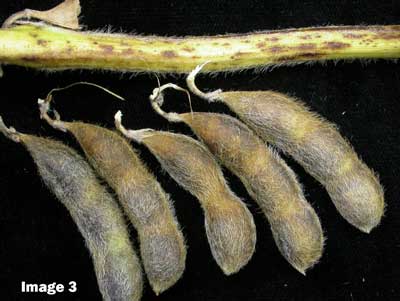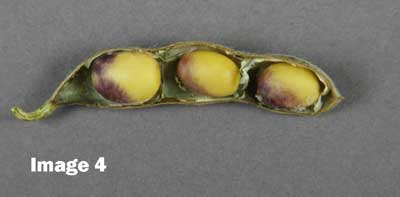
Cercospera Leaf Blight is a fungal disease caused by Cercospera kikuchii.- Foliar symptoms include a purple-orange-bronze discoloration of the upper foliage.
- Cercospera also causes purple seed stain, low seed quality, and reduced germination.
- Cercospera is transmitted via contaminated seed and spores.
- Crop rotation, residue management, disease-free seed, seed treatment fungicides and foliar fungicides are the most effective management strategies.
Biology and Life Cycle
Cercospera Leaf Blight (CLB) is a fungal disease caused by the pathogen Cercospera kikuchii, which is a close relative of the pathogen that causes Frogeye Leaf Spot. The pathogen overwinters in soybean debris and produces air-borne spores that are released from this debris. The pathogen also overwinters in infected seed. Infection can occur by planting infected seed or by germination of wind-borne spores that land on the plant. Seed-borne infections occur early in the growing season without any initial symptoms. As the infection progresses, foliar symptoms may be expressed during the reproductive phase. Spore infection is favored by warm temperatures (75-80 F) and high humidity at flowering.

Symptoms and Crop Injury
The first noticeable symptoms of CLB are elongated reddish-purple lesions on petioles in the upper portions of the canopy. Foliar symptoms appear in the late reproductive stage of growth as purple-orange-bronze discoloration in the uppermost leaves of the canopy. The leaves take on a leathery or sun-burned appearance (Image 1). These foliar symptoms are due to a photo-activated toxin produced by the pathogen. When infections are severe, defoliation may occur. Petioles will remain attached the plant. Lower portions of the canopy remain green. Distribution in a field is often uniform (Image 2.) Foliar damage is aggravated by hot, dry weather. Severe defoliation of the upper canopy may result in yield losses, but this is uncommon in the Midwest.
Cercospera also causes purple seed stain (Image 3). Purple lesions may be evident on stems and purple discoloration may be observed on pods (Image 4). Purple-stained seeds are smaller in size, have reduced germination, and poor vigor. The pathogen is transmitted via infected seed, and extensively discolored seed should not be saved for planting. Infected seeds sometimes show no signs of discoloration. There are no formally defined thresholds for CLB.
Management
Rotate to a non-host crop, like corn, to reduce pathogen loading. Use tillage to promote rapid decomposition of infected residue. Always plant high-quality disease-free seed and use a high quality seed treatment fungicide. Foliar fungicide applications during pod-fill (R3-R5) may reduce purple seed stain.
For additional reading, please see: Cercospera Leaf Blight (Soybean Research and Information Initiative)
Contact your FS Crop Specialist for your agronomic information.


Image 1: Bronze discoloration of soybean leaf caused by Cercospera kikuchii. (Source: GROWMARK, Inc.)
Image 2: Foliar symptomsof Cercospera in upper canopy of soybean field. (Source: GROWMARK, Inc.)
Image 3: Purple discoloration of stem and pods, caused by Cercospera. (Source: GROWMARK, Inc.)
Image 4: Image 4. Purple seed stain caused by Cercospera. (Source: GROWMARK, Inc.)